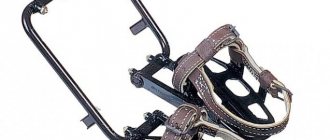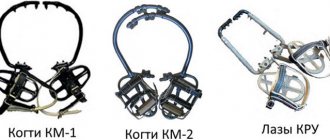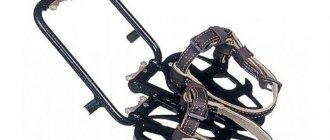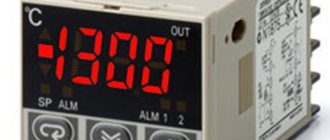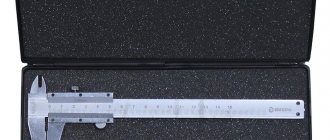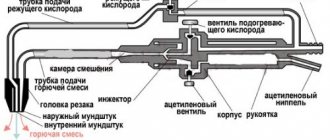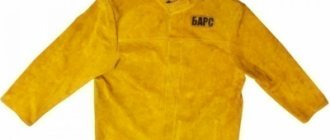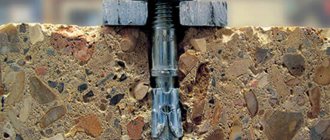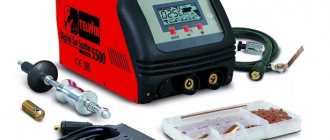During the operation of power lines, unexpected situations often arise, which is why they have to be repaired. And in such cases it is very important that this work is carried out as soon as possible. To quickly solve problems that arise, you need special equipment. First of all, you can’t do without such a device as cat’s claws or monter’s manholes.
The presence of such equipment for any organization that is responsible for the maintenance and installation of power lines is mandatory, since without it it is impossible to ensure long-term operation of power lines.
Inspection and testing: general principles
Claws and manholes used at enterprises must be inspected and tested for static loading every six months.
Before carrying out the next one, a complete visual inspection of the devices is carried out. If necessary, repairs are carried out, which may involve replacing the main parts. The devices are cleaned of dirt and dried at room temperature. Tip No. 2. It is not necessary to subject the straps used to secure the electrician’s foot to a load test. Their compliance with all current requirements is checked visually.
External examination of claws
A visual inspection of manholes and claws is carried out in order to identify damage visible to the naked eye, in the presence of which the devices are rejected. During the inspection of the claws, the technical condition and serviceability of all elements are checked:
- correct sharpening of the spikes;
- safety of the connection between the crescent element and the footrest;
- reliability of buckle seams;
- continuity of stitching of belts;
- the degree of tightening of the locking nut and the presence of a locking ring cotter pin.
Claw load test
Upon completion of the visual examination, identified deficiencies must be eliminated before testing the claws for static loading. The device, located in working condition, is loaded in the weakest section. The test is carried out on a wooden support stand with a diameter suitable for this claw model. The device must bear the load for 5 minutes without damage or rupture of welds, damage to the buckle or rupture of the belt. After release from the load, the presence of residual deformations is not allowed; their absence is checked by measuring the rise and alignment of the device before and after loading.
Visual inspection of manholes
When inspecting manholes, the condition is analyzed:
- bolts and connections;
- main components;
- removable plates;
- the presence of locknuts and cotter pins;
- belts and other fastenings.
The degree of sharpening of the removable plates, the reliability of their attachment, and for models of universal use, the condition of the cable loop nodes and the mechanism that regulates the opening of its solution are checked especially carefully. When checking the cable loop, the level of wear of the wires and branches of the paired spring tape and the quality of its attachment to the cable are revealed. Welding seams are checked for mechanical deformation and cracks. Damaged or sufficiently worn studs must be replaced with new ones.
Testing manholes under load
For testing under load, the manholes are placed on a stand in the working position, with the help of which the outlines of the lower part of the column are simulated. Upon completion of the inspection, the manhole is carefully inspected for residual deformations, tears in the fastening belts, cracks, and malfunction of the mechanism that regulates the opening of the cable loop. If at least one of the listed defects is detected, the hole is rejected and removed from the working stock.
Installer's claws for working on wooden supports
The design capabilities of assembler's claws for wooden supports, commercially produced in accordance with GOST 14331-77, are presented below:
- Type KM-1 – recommended support diameter 140...245 mm, throat 245±10 mm;
- Type KM-2 – recommended support diameter 220...315 mm, throat 315±10 mm;
- Type KM-3 - recommended support diameter 310...415 mm, throat 415±10 mm.
The platform of the KM series claws is stamped, with perforated holes, which makes it possible to increase the reliability of contact of the foot with the surface, while simultaneously reducing the weight of the platform. After stamping, the platform is hardened to a hardness of HRC 38...42. On one of the side surfaces of each platform there are ears for attaching steel arches. Along the remaining edges of the platform there are low sides, the presence of which prevents the electrician’s foot from accidentally slipping. To strengthen it during manufacturing, stiffening ribs are formed on the rear surface of the platform.
The fixing part of the arc rotates freely in the ears, ensuring the fixation of the spikes along the support at the moment of lifting the electric line operator. The permissible play should be no higher than ±15º.
The quick-wearing part of repairman's claws are the spikes, despite the fact that their initial hardness after hardening is 45...50 HRC. For claws on wooden supports, spikes are always made with conical tips. Experiencing significant frictional stress, steel spikes become dull and deformed over time. The durability of carbide studs is much higher, but they are sensitive to impacts and bending loads. Replacing the studs is not difficult, since their fastening part is threaded. The rear part of the platform is also equipped with spikes of a similar design.
The leg of the working person is attached to the arch of the claw using straps. In order to ensure elasticity, their upper part is made of yuft, and the lower part is made of rawhide impregnated with animal fat. The stitching of the belt elements is carried out with nylon threads, and the thickness of the belt and the diameter of the threads are calculated for a load of at least 140...160 kg.
Climbing harness for climbing at a climbing wall.
If you plan to do more than just bouldering, the next piece of equipment you'll need is a harness.
There are different models. Harnesses designed for mountaineering or sport climbing on natural terrain are very light, since you have to carry them in a backpack along with other equipment. However, this factor is not significant if you plan to climb only indoors. More importantly, you will have to spend a lot of time falling, falling and hanging on the rope, which means you should buy a comfortable harness with wide soft straps, designed for repeated falls.
Application area
Concrete hooks are designed to quickly lift a worker along a concrete or wooden power line pole to its upper section. Using personal equipment makes it possible to get the job done easier and faster than using a turret truck. It is not always possible to use special equipment. This depends on the terrain and urban density.
In manholes, an electrician is able to carry out installation and cable laying, carry out urgent repair work, and change lamp bulbs on wooden poles. Replacing lamps is often carried out through manholes, since due to the large number of lamp supports it is not financially profitable to use special equipment. It’s easier and faster for an electrician to climb up on his own.
What should you pay attention to when choosing climbing shoes?
Comfort and convenience. This is especially true at the entry level. If you feel pain even when putting on these special shoes, then you have chosen the wrong size.
Women's and men's models differ in fit: women's are usually narrower. At the same time, men often choose a female model, and women - a male one, it all depends on the individual shape of your legs!
Choose a last that leaves no space between the toes and the toe of the shoe, and the toes are only slightly bent.
Climbing shoes come with Velcro or lace-up. Velcro makes it easier to get on and off, but laces provide a more comfortable fit, especially if you have wide feet.
All rock shoes in "Kant"
Electrician's manholes, their types and application
Depending on their purpose, concrete power line supports can have different cross-sectional shapes:
- centrifuged (round);
- rectangular;
- trapezoidal;
- polygonal.
Types of electrical supports for power lines
Each type of support (see photo) has its own design of devices for safe and convenient maintenance of lighting elements.
Classification and purpose of the tool
Installation manholes, regardless of the type of work performed, must be equipped as follows:
- sickle (hook);
- thorns;
- step;
- leather straps to firmly secure the fitter's feet.
Electrical installation manholes
The sickle is the working part of the device, made of pipes of the required diameter with fastening elements (spikes) attached to it. The footrest looks like a flat metal structure. The installer's foot is secured using durable leather straps with clamps attached to the body of the footrest.
We advise you to study - Ohm's law for a section of a circuit and a complete circuit: formulas and definitions
All parts of the devices are designed for safe operation within temperatures from -40 to +50°C, and with proper use they retain their positive performance characteristics for 36 months.
Depending on the type of work and the shape of the lighting stand, installation manholes for concrete have several varieties:
- KLM (1–2) - claws of Laza montera. They are used for servicing trapezoidal and rectangular lighting poles. Hook opening 160–180 mm. The weight of the sets is respectively 3.7–5.4 kg.
Manholes KLM-1
- LMC - manholes on concrete for climbing and descending round or multifaceted pillars. The opening of the working part is 305 mm. Set weight 4.20 kg. Permissible force 180 kgf/unit.
Device for centrifuged supports
- LU - universal manholes with the ability to adjust the gripper opening. Grip opening 175–190 mm. The structure is adjusted using two bolts located on the device body. Product weight 5.8 kg.
LU-2
Necessary conditions for safe use of devices
The instructions for performing electrical installation work with your own hands provide for the following conditions:
- An electrician performing work at height must undergo training at a specialized center and obtain the necessary certificate allowing independent work.
- Before starting work, you must carefully inspect the device and make sure that all connections are secure, including the condition of the belts for securing the tool.
- The fixing belts must be made of two-layer fat-impregnated leather for installation work in any climatic conditions. The required belt thickness is 3 mm or more. The belt buckle must be made with a protective and decorative coating.
- Metal elements of manholes should not have cracks, dents, breaks or sharp burrs. Welding seams of connections must be smooth without visible defects. Working spikes should not be beveled and have the required geometric shape.
- The spikes of the device must move freely in the horizontal plane, but at the same time, the vertical play should not exceed 1 mm.
Safety belt
The video explains the rules of claw climbing and climbing.
Do-it-yourself claws for climbing poles - Metalist's Handbook
Electrician's claws are used for lifting electricians along wooden poles or reinforced concrete supports of power lines.
They are used if there is no aerial platform, or there is no way to quickly deliver it to a given pole, or there is simply an urgent need to make repairs.
Therefore, sometimes people make repair claws with their own hands, which is undesirable, as it can lead to injuries. The claws are also called monter's holes.
- general information
- Selecting a purchase by manufacturer and cost
- General design of installation manholes
- Equipment that should be supplemented with monter's claws
- Requirements for the installer
- Inspections and tests throughout the entire service life
- Trial of the Claws
- Storage conditions
general information
This equipment is divided into the following types according to its purpose:
- installer's claws for round wooden and metal supports (wooden poles are practically not used today);
- manholes for concrete for round and trapezoidal supports;
- claw holes with adjustable solution for trapezoidal reinforced concrete pillars.
The latter are the most common, as they can be used for any standard supports. But any of them should be used strictly on those supports that are indicated in their passports.
Any electrical installation company that installs or maintains power lines must have claws.
Manholes can be classified as universal tools; they are used in different climates with different temperatures from minus 35 to 55 degrees.
The manufacturer indicates the service life, usually it reaches a maximum of 60 months. After a year, the devices must be reviewed. Some items may be replaced.
Therefore, if there is a need to buy used repairman’s claws, then first you need to familiarize yourself with the inspection and testing rules. Used repair claws may not have any markings or operating instructions.
And high demands are placed on them - they must have sufficient strength, withstand the load of the installer, not wear out quickly, be comfortable, easy to adjust, and the spikes must be removable.
Selecting a purchase by manufacturer and cost
A person who is not yet familiar enough with this type of work should pay attention to the cost when purchasing.
In matters of safety when purchasing, it is advisable not to buy cheap manholes, since the low price speaks for itself of the poor quality of the materials.
For example, a person living in Moscow can type in the Internet search engine the phrase “installer’s claws for concrete pillars Moscow price”, then today he will see many options in terms of price and manufacturer.
It is better that the price is either medium or high. It is advisable to buy from a trusted manufacturer with a reliable reputation. There are quite a large number of manufacturers of claws of all types.
You can buy electrical installation claws made in Russia on the domestic market. These products are usually distinguished by high quality workmanship and reliability. In Moscow, you can always buy such repair claws.
All equipment must comply with TU, SNiP, GOST and current international standards. An appropriate quality certificate must be present.
It is also necessary to pay attention to the date of manufacture, trademarks, batch numbers, and manufacturer's warranties.
General design of installation manholes
The most common in their design are mounting claws used for wooden poles. They have two main parts:
- metal hook;
- belt.
The mounting hook has the shape of a sickle, trapezoid or rectangle. The hook is equipped with spikes for a strong grip on the support. The claws are usually made from high-strength steel and can be treated with anti-corrosion paint, which increases their service life.
Belts are made from thick two-layer leather, sewn in two layers, or from many layers of special rawhide or yuft, stitched with heavy-duty nylon thread.
In the case of climbing concrete pillars, climbing claws of a universal design are used.
For concrete poles, universal electrician's claws are suitable for trapezoidal shaped poles. Such manholes can be supplemented with carbide inserts that reduce slippage and wear of the claws. The total weight of the manholes is from 3 to 5 g.
Structurally, the fitter's claws on concrete pillars look like this: a footrest, an adjusting insert, an engagement bracket and a fastening belt. The mounting hook is made of a metal pipe and equipped with fasteners.
The footrest has plates with recesses for securing two layers of clamps.
Maintenance claws are quite simple; just grab the shoes tightly with the straps and fasten them. The lifting of the installer is carried out as a result of the self-fixing of hooks with spikes onto the pole. Moreover, the greater the weight of a person on the claw platform, the more reliable the fixation on the pole.
Equipment that should be supplemented with monter's claws
This includes a protective helmet and a safety belt with sufficient elasticity and ease of use so as not to interfere with a person. The safety harness will make it possible to cover the installer’s body and prevent him from falling accidentally.
Requirements for the installer
The installer must be over 18 years of age. He is required to have documents confirming access to steeplejack work. Have a medical examination certificate, permission to work, or the presence of an experienced supervisory specialist in the first year of work.
Inspections and tests throughout the entire service life
Usually the instructions contain a description of the test. The inspection is carried out every six months. First there is a visual inspection. Bolts, connections, plates and spikes, lock nuts and cotter pins of retaining rings, and belts are examined.
All additional elements - fasteners, clamps and cotter pins - must be in place. If we talk about universal claws, then it is necessary to check the cable loops and the mechanism’s opening regulator.
The cable loops are checked for the degree of wear on the wires of the branches of the spring tape and how it is attached to the cable.
Upon inspection, all metal parts should be free of defects, chips, cracks, sharp edges, seams at welding points should be smooth, and the belts should be quite thick. The stitching on the belts must be even and carefully secured. The spikes should be replaced if they are already dull or improperly sharpened, or if a defect or damage is visible.
Trial of the Claws
After visual inspection, the claws should be tested under static loading. The manholes are attached in working position to a special wooden or concrete stand.
Then, for five minutes, the weakest section with a force of 1350 N, then, for five minutes, the belt is loaded in the middle of the footrest, the belts are stretched for a minute with a force of 675 N.
After the load is removed, there should be no residual deformation, ruptures of welding seams, damage to belts or ruptures of buckles.
Even if the manholes are visually in perfect condition after 7 years of intensive use, they must be written off and no longer used. In addition to the claws themselves, before starting work, it is also necessary to examine the safety belt.
Without it, working at height is prohibited.
Storage conditions
Fitter claws and additional equipment are stored in conditions from minus 20 to plus 30 degrees. Manholes should not be stored outdoors.
After each use , they are cleaned, any remaining dirt is removed with a rag, and then placed in storage, where the average temperature is maintained and ventilation is provided.
Do not wash with water or wipe with a damp cloth.
Electrical claws and installation devices for climbing concrete and poles
In order to work on high-rise poles, pole climbing claws are needed. This allows you to avoid using aerial platforms to lift to the desired point.
Electrical installation claws ensure the safety of electricians and reduce operating costs.
In this article we will look at lineman's claws, lineman's manholes for concrete and other types of such necessary equipment.
Manholes and similar structures consist of steel parts that are arranged in a semicircle or perpendicular, as well as spikes that allow them to cling to the surface of the pole. They are attached to a special foot platform, which has straps to secure the worker's feet.
To keep it in an upright position, the kit includes slings and a harness to prevent a person from falling if the wire slips or falls. However, only one worker can lift such a device. If you need to lift two or more workers, you must use the services of a lift truck.
Care, storage, service life
Manholes are a universal device; they can be used in almost any climate zone with a temperature range from minus 40 to 50 degrees above zero. This means that work on power lines can be carried out both in the northern regions and in hot and sultry conditions.
The service life is indicated by the manufacturer. Time is counted from the moment the products are put into operation. No later than a year later, such a tool must be removed and recycled or disposed of. The maximum operating life of manholes is 60 months. Components are changed during operation as needed. The warranty period is usually 1 year from the moment the product is put into operation.
Store the device in a temperature range from minus 20 to 30 degrees above zero. It is unacceptable to store manholes in a room with an open roof; precipitation will leave a sharply negative mark on the quality of the devices.
Monter's manholes do not require special care. After use, they must be cleaned, any remaining dirt must be removed with a rag and stored away. Do not wash under water or wipe with wet material.
In conclusion of our article, we suggest watching a video of how assembly manholes are made and how to correctly lift using them:
Claws for climbing poles: materials of modern varieties of devices (100 photos)
The operation of power lines, like any other equipment, is impossible without damage or malfunctions that occur at the most inopportune moment. In order to eliminate them in a timely and efficient manner, it is necessary to have suitable tools and devices available.
To eliminate malfunctions in the operation of power lines, there are special tools, and even equipment that can be used to quickly get to the location of the breakdown. Such equipment is monter's claws (cat's claws, monter's manholes), which help you easily climb up the pole.
This type of equipment is an integral part of specialized equipment for performing work related to power lines, so they must be in the arsenal of any enterprise related to the repair of power lines.
Purpose
The main purpose of the claws is considered to be quick and convenient climbing up the pole in order to perform planned or unforeseen work.
The design of the claws is simple: the main element of the device is two hooks with straps attached to them, with which they are directly attached to the legs (each separately).
The device is made from durable and reliable metal, which guarantees safety when working at heights.
The diameter of the hook is slightly larger than the parameters of the circle post. To conveniently and correctly climb up or down, you need to install the hook perpendicular to the vertical pole. Otherwise, the worker will not be able to move up or down. How difficult is it to climb a pole without claws?
Materials used
Wooden poles for power lines have been replaced by reinforced concrete poles that are more durable and resistant to use.
In this regard, the linemen's manholes also underwent some changes: they began to use inserts made of harder alloys, as a result of which the likelihood of them slipping decreased and the potential of the device increased.
The most commonly used claw material is high-strength steel, coated with an anti-corrosion protective layer for greater durability.
The structure of the belts is multi-layered; yuft and rawhide are used as the main material for their production; in addition, in the end they are also stitched with nylon threads for greater reliability.
Varieties and properties
To perform the work efficiently and efficiently, it is necessary to use suitable equipment and tools. To move along a wooden pole, you should select the appropriate claws, for concrete ones - similarly.
Today, claws used for climbing poles are classified into:
- linemen, which are used to move along round metal or wooden poles, but they are now practically not used.
- assembly manholes for concrete supports, designed for movement on pillars with a round or trapezoidal cross-section. It is considered the most popular type of claw.
- assembly manholes for climbing reinforced concrete supports with a trapezoidal cross-section in diameter. Plus, they can be customized and used for any type of power pole.
Auxiliary elements
Any specialist servicing power lines must have a full arsenal of tools and devices to perform the work. It must include: a protective helmet and a safety lanyard.
Selection rules
To make the right choice of claws, you need to have some knowledge in this area. When choosing a device, you should pay attention to the following nuances:
Product price. In this case, it is worth remembering that cheaper versions of the claws may use insufficiently high-quality metal, as a result of which the device will be unreliable and dangerous. Focus on medium or high price, which guarantees quality.
Manufacturer. As you know, it is better to trust proven and well-known manufacturers.
Quality. Products must comply with current GOST or TU and have quality certificates. Upon external inspection, no defects or unevenness of the seams should be noticeable. The thickness of the belts must be at least 0.3 mm, the stitches must be even and securely fixed.
and exploitation
Conditions of maintenance and operation are simple. Post claws are suitable for use in all temperature zones. The safe use period is indicated on the label. During their use, it is necessary to carry out preventive inspections and, if necessary, change components. Clean your claws regularly.
Storage conditions
It is recommended to store claws in a dry, well-ventilated area at a temperature of -20 to +30 degrees.
If damage to the claws is detected, you should stop using them, have them repaired by a specialist, or replace them with new ones.
Photo of claws for climbing poles
Review of brands and manufacturers
The following companies deserve mention and are trusted by consumers:
- CJSC "Potential";
- electrical engineering plant KVT;
- production association "ZMO".
(Nizhny Novgorod)
Installer's claws No. 2, manufactured (Nizhny Novgorod) are used for electrical installation work on wooden vertical supports or wooden poles with reinforced concrete attachments for overhead power lines. The opening of the device is 315 (±10) mm, the lift is 160 (±10) mm.
- The diameter of the supports allowed for use is 220-315 mm.
- The cost of the device is about 2-2.5 thousand rubles.
- The main characteristics of claws No. 2 2 are presented in the table.
Products of the KVT enterprise (KVT electrical plant)
The KVT enterprise produces the popular and sought-after model of KLM claws in two versions - KLM-1 and KLM-2. Both options are used for work on trapezoidal overhead line supports.
- KLM-1 ensure safe operation on columnar supports of types SV110-1a and SV110-2a. The claw length is 168±4 mm, weight is 5.3 kg. The price of KLM-1 claws, depending on the region, is 2.2-2.8 thousand rubles.
- Claw-holes KLM-2 weighing 5.4 kg and opening 190±4 mm are widely used for posts SV105-3.6 and SV105-5. The cost of the device is approximately 3.5 thousand rubles.
Comparative characteristics of the KLM-1 and KLM-2 claws are presented in the table.
Production Association "Installation Equipment Plant"
The production association "Installation Equipment Plant" boasts two popular models. KM-1 claws are widely used for work on wooden and wooden with reinforced concrete inserts power transmission line supports, on communication line poles with a circumference of 140-245 mm.
- The forged sickle and spikes are made from reliable 40X steel and are supplied with leather straps. The device's opening is 245±10 mm with a fairly low mass of 3.6 kg. The cost of KM-1 ranges from 2400 to 2900 rubles.
- Universal switchgear manholes are used on supports of trapezoidal cross-section of overhead lines of the SV110-1a, SV95-1(2a), SV105-5 and SV105-3.6 brands. The manhole has an adjustable opening in the range from 168 to 190 mm. Reliable adhesion to the surface of the supports is ensured by carbide spikes. Supplied with leather straps.
- The weight of the product is approximately 5 kg.
- KRU manholes can be purchased for 2900-3700 rubles.
Comparative characteristics of KM-1 claws and KRU manholes are presented in the table.
Terms of use
There are special instructions for electricians that tell you how to use electrician's claws. First of all, it is necessary to take certain safety measures when performing various works in electrical networks, especially on power lines.
- Before starting work, you need to agree on the procedure, draw up all the necessary documents, prepare the workplace and allow workers to complete the task. These measures are extremely important and necessary in order to protect workers. For example, when an electrician is working, voltage may be applied to live parts (namely wires).
- You need to be able to properly use the protective insulating equipment used during work.
- Installer's claws are used exclusively for those supports that are indicated in the device's passport.
- Before starting work, you need to check the product for damage and check the test date. In this case, yarns and belts, bolted connections, welds, fasteners, and spikes are checked. Electricians who use assembly claws must undergo additional instruction and training. They are also tested on their knowledge and checked whether they have a record of permission to carry out the work independently.
- Twice a year, claws and holes should be sent for inspection. This is necessary in order to detect and correct a defect or malfunction in a timely manner.
- If the integrity of the device is compromised (for example, there is a crack or a hangnail), then they are not allowed to be used.
- In addition to the structure itself, before carrying out work, you need to separately check the safety belt and climb the pole only with it.
- It is prohibited to change anything in the structure of the device or its belts.
- It is strictly forbidden to climb a pole through which fault currents passed to the ground.
- The structure must be stable and integral.
We advise you to study - Malfunctions of lamps with fluorescent lamps and their repair
The video below clearly demonstrates how to use lineman's claws when climbing onto a support:
DIY claws for climbing poles
- 1 Claws for climbing poles with your own hands - Metalist's Handbook
- 2 Monter's claws and manholes: types, purpose, rules of use
- 3 Claws for climbing poles and trees
- 4 Claws for climbing poles: materials of modern varieties of devices (100 photos)
- 5 Claws for climbing poles: reinforced concrete and wood, electrician’s tools for work
- 6 Operation of claws for climbing poles: types, selection, storage - SibNovStroy
Electrician's claws are used for lifting electricians along wooden poles or reinforced concrete supports of power lines.
They are used if there is no aerial platform, or there is no way to quickly deliver it to a given pole, or there is simply an urgent need to make repairs.
Therefore, sometimes people make repair claws with their own hands, which is undesirable, as it can lead to injuries. The claws are also called monter's holes.
- general information
- Selecting a purchase by manufacturer and cost
- General design of installation manholes
- Equipment that should be supplemented with monter's claws
- Requirements for the installer
- Inspections and tests throughout the entire service life
- Trial of the Claws
- Storage conditions
Structure
Monter's manholes (claws) are a design of two main parts:
- metal hook;
- belt.
The hook has the shape of a trapezoid or rectangle. For strong adhesion to the support, it is equipped with teeth and self-adjusting spikes. The belts are made of genuine leather, sewn in two layers. The total weight of the structure is from three to five kilograms.
The laz works using momentum: different levels of spikes allow the hooks to be more firmly fixed under the influence of a person’s weight. The more weight, the better the grip. The gravity of the body, whatever it may be, will create the necessary moment of momentum, allowing you to maintain the required mass.
Care, storage, service life
from - 40 to + 50 degrees
Each product has a certain service life, which must be indicated in the labeling. Its starting point is the moment when the device was first used for its intended purpose. However, after a year of active use of the tool, operation is stopped, and the tool is sent for recycling or disposal. All manholes have a service life limit of 60 months. To safely perform work on power lines, it is necessary to regularly change components. If all requirements for production technology are met, such a device can work effectively for a year from the moment it is put into operation.
Manhole storage
It is unacceptable to leave claws for storage in the open sun or in rooms where a humid environment is maintained. In order for the manholes to retain their quality characteristics even after the inactive period of operation, they must be kept in a warehouse where an average temperature regime is maintained and ventilation is provided.
If any part is faulty, then a specialist should not repair them if he does not have the necessary experience and knowledge. If any element of the tool is faulty, then it is unacceptable to use it.
In order for assembly manholes to perform their task equally effectively, they do not need to provide special care. To do this, it is enough to clean them from dirt after each use, using any rags, after which they are placed in a storage place. It is unacceptable to use wet material to clean claws.
Design and principle of operation
The simplest manholes for concrete supports consist of 2 elements for attaching to shoes, each of which consists of the following main components:
- Oval foot support with transverse reinforcements;
- 2 straps holding the foot on the platform;
- “Sickle” is a rectangular grip with 4 conical spikes attached at an angle of approximately 600 to the supporting platform.
Climbing onto a reinforced concrete pole using a similar device occurs as follows:
- The electrician securely fixes the manholes on his shoes using belts;
- Approaching the pillar, he grabs it with the grips of each of the elements of the claws;
- The electrician climbs the pole, thanks to the fact that the claw grips, which he alternately rearranges in the vertical plane, located at an angle to the supporting platforms, bite into the concrete with their spikes and prevent slipping.
Using a similar principle, electrical claws designed for this type of support help you climb onto a wooden pole. Their only differences from the crampons used for concrete pillars are the semicircular shape of the grips and softer spikes.
Defects in mounting claws
The main defects that can be found in an electrician's claws include the following:
- Cracks – such damage includes a violation of the integrity of the metal structures of the supporting platform, grip;
- Burrs are sharp edges of cracks in metal parts that, in contact with belts, can cause damage;
- Tears and fraying of retaining belts - with prolonged use, the material of the belts, gradually losing strength, begins to tear and separate into fibers, which is visually manifested in the form of terryness and clearly visible transverse tears;
- Deformation and reduction in the strength of the studs - caused by natural fatigue of the metal, this defect manifests itself in the partial or complete loss of this element of its main functions.
Note! If one of the above-described defects is detected in factory-made models, experts recommend not to repair them yourself, but to take them to a specialized workshop for repairs. It is prohibited to use such installation equipment even with minimal damage.
Safety Precautions - Inspection and Testing
When using this device, specialists working at height must have additional equipment in their arsenal in the form of a protective helmet, which will protect against an accidental blow, as well as a safety lanyard, which will help to avoid serious consequences.
Straps for fastenings should also be available. The design of the belts must guarantee convenience and reliability in use, therefore their thickness must be at least 3 mm. These devices are made of two-layer leather, which is impregnated with fat. Each access hole must be marked with the date of the next inspection.
Before climbing to a height, you should thoroughly inspect the claws and check the test date. In addition, it is necessary to ensure the reliability of the welds, the integrity of the spikes, and the serviceability of the worm mechanism.
The metal elements of the device must not contain dents, breaks, sharp edges, cracks, or burrs. The spikes must not be damaged, beveled or knocked down. It is prohibited to use claws whose spines are blunt or absent altogether.
The device must be loaded for five minutes, with the load passing through the center point of the footrest. Before testing, a visual inspection is carried out to ensure that all parts are fastened and that there is no damage to the belt firmware. The fixing nut must be tightened with a locking ring.
In addition, the correct sharpening of the spikes is checked. The tests are carried out on a wooden support, the diameter of which corresponds to the numbering of the claw. After testing on the claws and manholes, there should be no deformation of the elements, damage to the welds, or breakage of the belts. Then measurements are taken, which are compared with previous values and recorded in a special journal.
If, after loading, defects are revealed, then such devices must be repaired; spikes and other damaged components are replaced. After troubleshooting, the device is again subjected to load.
Types of indoor climbing
Before you go shopping for equipment, it's important to understand the differences between the three main types of climbing found in climbing gyms.
Entering the gym, you will see shorter walls with holds, 3-4 meters high, under which there are thick sports mats, and higher ones, usually 10-15 meters, sometimes higher, from which ropes hang or a track of guy ropes is hung.
Bouldering
Short walls without ropes or guys are designed for bouldering. Completing a boulder route is called a “challenge” among initiates.
The main advantage of bouldering is its social orientation. You can easily find yourself in a crowd that is passionate about climbing one “problem”, as opposed to the more individualized rope climbing. In addition, many people prefer to climb in bouldering gyms because the only necessary equipment for this is climbing shoes and a bag of chalk. And finally, bouldering is the “cleanest” type of climbing, where there are no ropes and no person to belay you. Just you and the rock. Many people are attracted to this freedom of climbing.
Top rope climbing
High walls with ropes hanging on them are designed for top rope climbing. Each section where the rope hangs is simply called a "route". This is the safest form of climbing and is ideal for beginners. You will have to overcome the fear of heights factor, but it gradually disappears as you develop trust in the equipment and your partner, who will belay you and, in case of a fall, will keep you from falling with the help of a rope.
For climbing with a top rope, in addition to climbing shoes and a bag of magnesium, you will need a harness, a carabiner and a belay device.
Climbing with a bottom rope
High walls without ropes are designed for climbing with a bottom rope in ropes using quickdraws to organize the belay. This advanced form of rock climbing requires technical skill and also carries higher risks than top rope climbing. In the bottom belay, the rope is not passed through the carabiner at the top; the belayer releases it from below. When climbing the wall, you need to snap it into the guy ropes hanging every 2-3 meters. In the event of a fall, the flight will be the distance to the last guy into which you managed to snap the rope, plus the same distance below it and a meter or two by which the rope will spring back and etch the safety device. The thrill of falling is guaranteed, but the risk of serious injury in the gym is minimal. However, bruises, dislocations and other injuries are possible, so at first you should climb under the guidance of a coach, and in the future take seriously the assessment of your level and technical skills before choosing the next route.
For climbing with a bottom rope, in addition to all the above equipment - climbing shoes, a bag of magnesium, a harness, a carabiner and a belay device - you also need quickdraws. At some climbing walls, they can be hung, like ropes for the top rope. But advanced climbers prefer to bring their own and climb, clicking guy ropes into the safety anchors themselves. This is the “purest” style of climbing a climbing route, completely simulating the work of a rope on natural terrain.
Care, storage, service life
The effectiveness of the claws is that they can be used at any temperature from -40 to +50 degrees. This device can be used in work both in hot areas and in the far north.
The invention is used only for a limited period. With constant use, the claws are used for no more than a year. The maximum service life is 5 years. In addition, it is recommended to periodically replace components. When using this method of lifting onto air supports, you must strictly follow the operating rules specified in the instructions.
The best storage temperature for the device is considered to be from -20 to +30 degrees. This will not interfere with its effectiveness in use. In order not to spoil the functional properties, repair claws are stored in a dry, well-ventilated area. Also during storage it is necessary to avoid sunlight.
In addition, to preserve the manholes, it is necessary to clean them from dirt and wipe them dry after each use. If the claws are wet, they must be dried and taken to a warehouse or other room that maintains the required temperature for storage and ventilation.
We advise you to study - Open and closed loop regulation in control and automation systems
If one of the device components breaks down, its further operation is strictly prohibited. Repairs should only be carried out by a specialist in the field.
Proper storage conditions
After each use, the claws must be cleaned of dirt, rust, concrete dust or crumbs.
Claws for climbing poles should be stored suspended (on hooks or special hangers), in well-ventilated, dry areas out of the reach of children and pets.
Another advantage of such equipment for installers and electricians is the possibility of making it yourself - on the Internet you can easily find both a visual drawing and video instructions for assembling claws from scrap materials with your own hands.
Operating rules
Work at height has an increased danger, which is why there are a number of rules for its implementation and operation of equipment. Every worker - a high-altitude worker, an electrician - must know and apply the following rules for using assembly claws.
- The equipment may only be used for its intended purpose. This means that when climbing up a concrete base, you need to use claws that are designed for that material.
- You must adhere to safety rules.
- It is worth considering the technical characteristics of the claws, because each model has a certain maximum load capacity.
- Before putting on the device, it must be checked, namely the spikes and belts for deformations. Every bolt, tenon, strap and fastener must be free of damage. If defects are found on at least one of the parts, it is strictly not recommended to use the equipment.
- Carefully study the product data sheet. The document must indicate the expiration date and dates of mandatory inspections.
- You need to have your claws checked at least twice a year.
Also, experts do not recommend using claws from dubious and little-known manufacturers in high-altitude work.
There is a certain permissible operating temperature, which is also indicated in the product passport.
Watch the video about monter's claws below.
Types and their characteristics
You can purchase the required type of manholes by deciding on their purpose. If you plan to work on wooden poles, then you should buy one type of device. When working on concrete supports, a different type is chosen.
Manholes are divided into several types:
- lineman's claws (for round metal and wooden poles), now they are practically not used;
- assembly manholes for concrete (for round or trapezoidal concrete pillars), very common;
- Installer's manhole claws (for supports made of reinforced concrete in the shape of a trapezoid) are quite popular, the opening of the manholes is adjustable, which allows them to be used on any support.
Where and how to use a safety lanyard, read in this publication.
A safety harness is used to cover the worker’s body to prevent him from being caught in the future. What are the requirements for a harness, read here.
DIY pole climbing claws - Metals, equipment, instructions
In order to work on high-rise poles, pole climbing claws are needed. This allows you to avoid using aerial platforms to lift to the desired point.
Electrical installation claws ensure the safety of electricians and reduce operating costs.
In this article we will look at lineman's claws, lineman's manholes for concrete and other types of such necessary equipment.
Manholes and similar structures consist of steel parts that are arranged in a semicircle or perpendicular, as well as spikes that allow them to cling to the surface of the pole. They are attached to a special foot platform, which has straps to secure the worker's feet.
To keep it in an upright position, the kit includes slings and a harness to prevent a person from falling if the wire slips or falls. However, only one worker can lift such a device. If you need to lift two or more workers, you must use the services of a lift truck.
Next, we will consider the main types of such devices depending on their purpose.
Main types of devices
Electrical claws have many modifications. However, the most used and practical are the following designs:
- Universal claws;
- Monter's claws;
- Montersky manholes KRPO;
- Monter's claw-holes KCO.
Universal claws are suitable for trapezoidal concrete supports of any height. The design consists of the following elements: footrest, hooking bracket, adjustment insert, fastening belt.
The hook is made of a metal pipe with fasteners. The footrests have special plates with recesses that allow you to fix two layers of leather clamps.
The buckles in such claws unfasten quickly and without problems, which makes them especially valuable in work.
The fitter varieties of claws and manholes, as well as the connected type, are designed to work with supports of any cross-section, weighing from 3 to 5 kilograms and a coverage of 168 to 315 millimeters.
Also suitable for working on centrifuged power line poles. Includes carbide metal spurs and leather clamps.
Having considered the main types of such structures, let’s move on to some points that help to work with them correctly.
Monter's claws for climbing wooden posts
Electrician's claws are used for lifting electricians along wooden poles or reinforced concrete supports of power lines.
They are used if there is no aerial platform, or there is no way to quickly deliver it to a given pole, or there is simply an urgent need to make repairs.
Therefore, sometimes people make repair claws with their own hands, which is undesirable, as it can lead to injuries. The claws are also called monter's holes.
- general information
- Selecting a purchase by manufacturer and cost
- General design of installation manholes
- Equipment that should be supplemented with monter's claws
- Requirements for the installer
- Inspections and tests throughout the entire service life
- Trial of the Claws
- Storage conditions
What it is?
Claws or claws are special devices for lifting a worker onto a power line pole. They are fixed on a person’s legs and make it possible to gain a foothold on a support and stay in one position for the required amount of time. The structure of the manholes will be improved to increase the reliability of the equipment and the speed of climbing to the top. There are three groups of such devices:
It is convenient to climb the round pillars using universal equipment.
- Lazy. Designed for lifting reinforced concrete structures of round and trapezoidal shape in section.
- Universal hooks. The installation tools are suitable for round pillars made of concrete or wood. The latter have lost their relevance.
- Claw-holes. They differ in structure. Equipped with a specific control solution, especially effective in relation to trapezoidal reinforced concrete supports.
The latter devices are used more often than other types, because their specificity allows this device to be used to work with all types of standard supports. The use of manholes is permitted if this possibility is confirmed by accompanying documents. Each company specializing in electrical installation has its own set of tools for servicing power lines.
What should you pay attention to when choosing a harness?
Harnesses intended exclusively for indoor climbing may have a simplified design - with an adjustable waist belt, but without buckles on the leg rings, since in the gym you always climb in thin indoor clothing.
Universal safety harnesses, in which you can both climb on a climbing wall and climb in the mountains, have adjustable volume of the belt and leg loops. Adjusting the leg loops is especially necessary in the mountains, when the harness must be worn over clothing of varying thickness and volume - from a T-shirt and shorts in warm climbing areas to insulated pants and jackets in high altitudes or winter. In addition, the removable leg straps allow you to remove or put on additional warm or windproof trousers without unfastening the rope and without losing your belay.
Harness PETZL luna violet
9 990
Buy
-50%
Salewa hardware rock w harness ( m/l ) reef /
3 490 6 980
Harness PETZL 2022 corax blue jean
6 800
-30%
Black Diamond momentum harness
4 193 5 990
Modern models of harnesses are equipped with quick-adjustable Speed Adjust buckles (Black Diamond Momentum), thanks to which there is no need to fix the belt in the opposite direction after each adjustment, which makes their use safer. Many climber accidents have occurred when they forgot to lock the strap in reverse.
There are 2-4 loops on the waist belt of the harness for hanging equipment - quickdraws, anchors, hooks, loops and other equipment. Models intended for the gym may have only two loops - for a bag of magnesium, several guy ropes and a safety device.
There are women's models designed taking into account the female anatomy. For example, Black Diamond Primrose or Salewa Hardware ROCK W. But when buying a harness, as well as when choosing climbing shoes, an individual approach is important. It is necessary to try on each model and hang in it - all specialized outdoor stores, including Kant, provide this opportunity. This way you can choose the harness that suits you.
Safety harnesses have a range of sizes - S, M, L. If universal use is intended, then it happens that the girth range of one size is not enough for the harness to sit evenly on a thin T-shirt with shorts and on a thick down jumpsuit. It may turn out that when worn on shorts, it will be too loose, but on thick winter clothes, on the contrary, it will be too tight, causing the safety loop to slide to the side. All this can cause inconvenience during the climb, and if you fall, it can twist or turn over. In this case, the best solution is to choose a universal model with double-sided belt buckles. The downside is the extra weight of the extra buckle. Plus, you can more accurately adjust the fit no matter how many clothes you wear. For example, the popular model Black Diamond Momentum or the PETZL Corax, also well known and loved by climbers.
And one more important point. The harness must have safety certification - UIAA or CEE. Large outdoor stores, such as Kant, sell only certified safety equipment.
All models of harnesses in "Kant"
Operating rules
Each enterprise involved in the operation and maintenance of power lines must develop its own instructions for the use of manholes. However, the main sections of the rules do not differ significantly. The main message of the instructions is that personnel must be able to operate tools and devices, which include claws. Among the basic rules are:
- The devices should only be used on the types of poles specified in the instructions.
- Before starting work, you need to make sure that the claws are in good condition.
- During the inspection, all connections, tenons and fasteners should be inspected.
- Personnel performing work at height using manholes must undergo training and then pass an exam. After this, a permit is issued to carry out the work independently.
- Devices must undergo mandatory inspection once every six months.
- If a design malfunction is detected, the claws and manholes must be removed from the working stock.
- Before starting work, the employee must check not only the device itself, but also the safety belt.
Purpose and purpose
The main purpose of assembly manholes is to create conditions for quick ascent to a vertical pole where it is necessary to perform certain work. Quite often, this device is used in situations where it is necessary to carry out repair, installation or maintenance work.
The basis of the climbing claws is formed by two hooks, to which toothed belts are fixed, ensuring the fastening of this device to the leg. Due to the fact that this device is made of metal, this tool is highly rigid, which ensures safety during work.
The hook of this device has a diameter that exceeds the size of the post . In order for the leg to be moved up or down, the hook must be placed at a right angle relative to the axis of the post. If it is located at an angle to the axis, this will not allow the maintenance personnel to move. However, it is precisely this position that allows workers to ensure reliable attachment to the support for safe work at heights.
